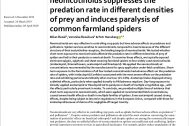Obsah
Neonicotinoids are very effective in controlling crop pests but have adverse effects on predators and pollinators. Spiders are less sensitive to neonicotinoids compared to insects because of the different structure of their acetylcholine receptors, the binding targets of neonicotinoids. We tested whether short-term exposure to neonicotinoids affected the predation rate in different densities of prey of spiders and led to their paralysis or eventual death. To examine these effects, we topically exposed dominant epigeic, epiphytic and sheet-weaving farmland spiders to four widely used neonicotinoids (imidacloprid, thiamethoxam, acetamiprid and thiacloprid). We applied the neonicotinoids at concentrations recommended by the manufacturers for spray application under field conditions. Short-term exposure to the formulations of all four tested neonicotinoids had adverse effects on the predation rate of spiders, with imidacloprid (Confidor) associated with the most severe effects on the predation rate and exhibiting partial acute lethality after one hour (15–32%). Acetamiprid also displayed strong sublethal effects, particularly when applied dorsally to Philodromus cespitum. Day-long exposure to dorsally applied acetamiprid or thiacloprid led to paralysis or death of multiple Linyphiidae spp., with the effects particularly prominent in males. To conclude, we provided multiple lines of evidence that short-term exposure to neonicotinoids, which were applied at recommended field concentrations, caused severe health effects or death in multiple families of spiders. Even acetamiprid caused strong effects, despite being subject to less strict regulations in the European Union, compared with those for imidacloprid because of claims of its negligible off-target toxicity.



